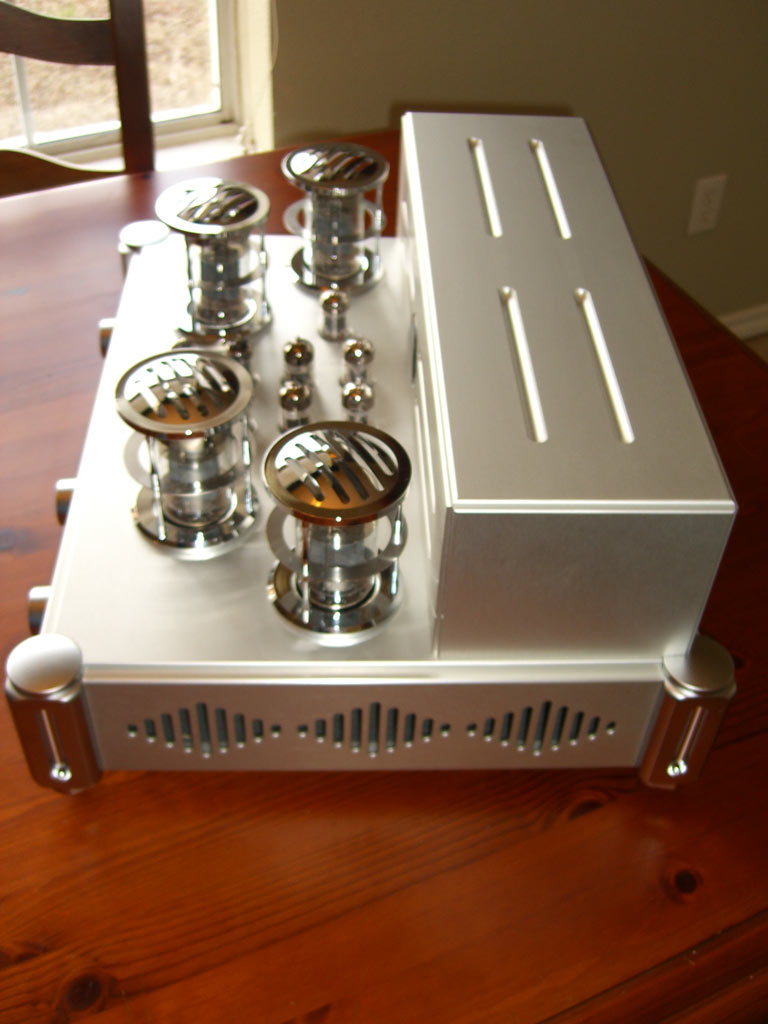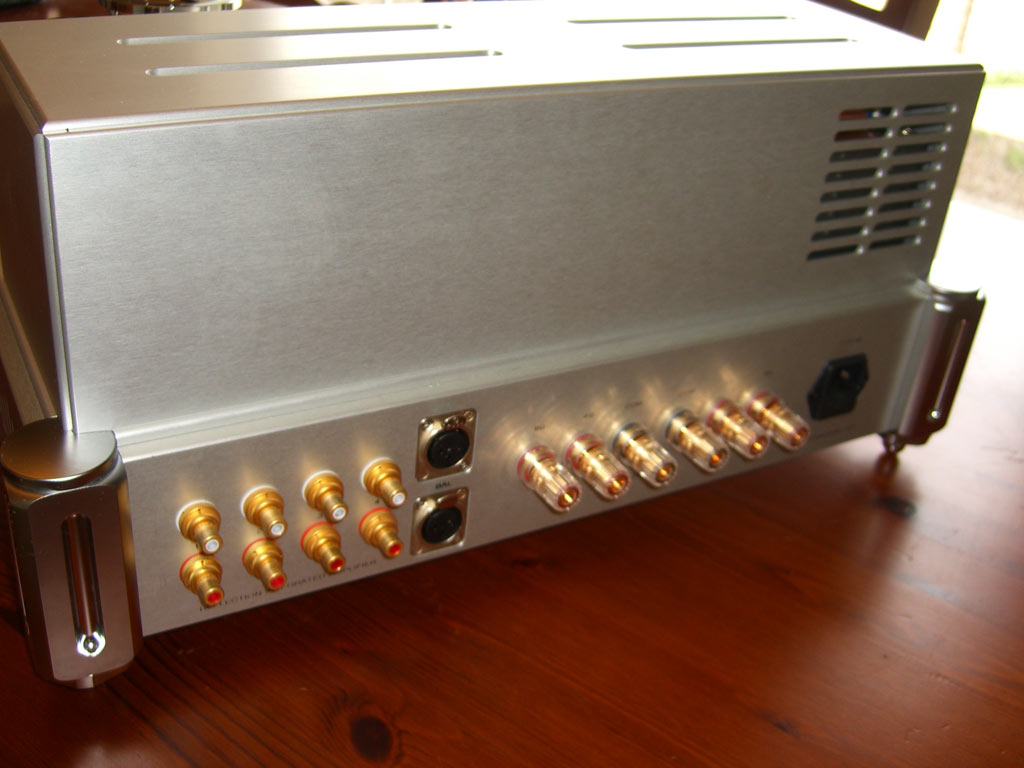Hyper Realism
The thing that distinguishes the Raven from similar units is boldness. It cuts very dramatic lines, emphasizing scale and macro-dynamics over detail and micro-dynamics. Where many integrated amps sound timid or laid back, the Raven is anything but. It’s not clumsy though. If the Raven were a running back, it would be Adrian Peterson, rather than Jerome Bettis, a downhill runner of the first order. Peterson is not as elusive as Gale Sayers, but he is still maneuverable. Similarly, the Raven’s powerful sound can be a bit much on over-hyped pop recordings. However, on many classical and jazz recordings, the boldness of the Raven brought life to musical lines and the interplay of instruments. I am convinced that it’s impossible for a piece of equipment to be “equally good” on all types of music, or for all listeners. With the Raven integrated amp, polite recordings are given life, and lifeless components, especially speakers, are somewhat reanimated.
Evidenced by the unit’s enormous weight, the output transformers are very large, and have full bandwidth, at full power, down to the last octave. The quality and quantity of bass is surprising for the modest 50-watt rating. I’ve never heard such authoritative bass from an integrated tube amp. I believe that the amp puts out well over 50 watts on peaks, because it sounds much louder than that. Even when playing loud, the low bass is full, deep and controlled. AC core saturation is omnipresent with most affordable tube amps. For full bandwidth at full power, a massive core is necessary. Most companies will scrimp on transformer core size to lower cost and weight of the final product. Bass and dynamics suffer accordingly.
Another aid to powerful bass reproduction is the use of a cathode follower at the output of the preamp section, to drive the amplifier section. The cathode follower is also somewhat responsible for the amps emphasizing scale and macro-dynamics over detail and micro-dynamics. It’s a somewhat controversial circuit, the cathode follower, but more often than not, the circuit falls victim to designers who abuse it. When the proper tube and operating point are chosen, it acts as a virtual transformer, but without the high cost and the loss of gain that an equally effective transformer would penalize you. The cathode follower acts as a transformer: both have very high input impedance and very low output impedance, but unlike a transformer of similar specs, the circuit is almost unity gain. The best cathode followers are usually low to medium mu tubes and with low plate resistance. A step-down transformer would lose many decibels of gain making the same change in impedances, from high to low, and the loss in gain would force you to add more gain to the ensuing circuit.
I don’t think the Raven will mate very well with some horns. Horns tend to enhance dramatic tension, dynamics and detail, and need a partner that will “keep calm and carry on.” In other words, there’s a reason relatively weak single ended amps sound good with horn speakers, they are good partners. From my experience, the Raven is a better match for complicated speakers that need plenty of “oomph.” Though I didn’t have a pair on hand, I believe it would be a good match, in smaller rooms, for the inefficient Magnepan. Also, because the sound is rather “taught,” bass reflex designs will have less overhang. Raven also makes appropriate amps for high efficiency horns.
The soundstage and presence are very big, with good center-fill and good continuity from the outside of one speaker, to the outside of the other. Images are distinct and vivid, with very little “smear.” They are pushed slightly towards the listener. As a result, I moved the listening position farther from the speakers to get a more neutral result. If you like to listen in the near-field, you will like what the Raven achieves. While the images are slightly forward, the amp still clearly reveals when multiple images are layered, or when a spot mic for a soloist has been mixed with a different set of mics used to capture the ambience of an ensemble in an acoustic space. As such, some vocals were solidly center-mono, acoustically dry and pushed forward, with the ensemble in a different acoustic space that was distinctly behind the soloist and spread from the outside of the speakers, in. I did get convincing images behind the speakers, but usually on well recorded classical and big band jazz. The amp does accurately identify different recording techniques and gimmicks.
The textures are very tube dependent. There are thousands of possible tube combinations, from dirt cheap Chinese produced tubes, to the rarest NOS tubes. With the stock tubes, textures were granular. After switching out the stock Russian tubes, the textures were more delicate and finely detailed. I think the difference is attributable to the lower distortion of NOS tubes. Even with upgraded tubes, the Raven, and almost all integrated push-pull designs, subtly change the textures which give music the breath of life. This is where single-ended designs and a very few push-pull designs, are strong. The integrated amps that get this right mostly use 300B, 6c33c and are single ended. Unfortunately, they are usually much more expensive and much less powerful. Even the high powered single-ended integrated-amps, especially ones that use the 211 and 845, the Ongaku being a notable exception, tend to get textures wrong. The Raven 300B amps sound significantly different, with better nuance and textures, proving the theory. Unless you have Kondo Ongaku money, you have to choose what is most important to you.
After getting accustomed to the Raven Reflection, other amps sounded decidedly polite and timid. Can an amp be “too dramatic” or “too powerful” sounding? I don’t see how it’s possible to create artificial drama without resorting to EQ and dynamic expander circuits, both missing in the Reflection. My conclusion then, is that the Reflection is an excellent sounding integrated amp, with plenty of power and flexibility. Depending on your speakers and room, the Raven could be what you need to liven up your system.
Designed in Korea, Built in Texas
I’m sure I’m slightly biased towards the Raven. I admire what the South Koreans have accomplished. It is a most technologically advanced society in the world. At the same time, I admire owner Dave Thomson’s desire to have these amps built locally, with as many American pieces as possible. That the amp sounds good is proof that international cooperation works.
It’s a young company, yet Raven Audio’s components look, feel and sound like they are from one long-established. That bodes well for the future success of Raven Audio. Since Dave offers an in-home trial, plus personalized transport and setup, you should feel confident in giving their Reflection a try. I know I’ll miss it when I send it back to Dave.
- ← Previous page
- (Page 2 of 2)




Thanks Philip and Constantine for publishing this honest review for the Reflection Integrated Amplifier in Dagogo! We do indeed offer a mix of mostly NOS and some currently manufactured tubes with all of our “Elite Series” (hand wired machined anodized aluminum case) products.
Since the worldwide stocks of NOS tubes are dwindling we try our best to personally discuss with each of our customers, just what tube complement will work best in their new Raven Audio amplifier.
It’s a very personal choice of course, and we try to find out what music they prefer to listen to most of the time, and what equipment they have in their systems, and then try to give them the tube combination that we think will work best for them, considering their music library, speakers, DAC, source etc. As long as we can we always will do this.
Thanks Guys! We do appreciate the review.
Sincerely,
Dave Thomson
Raven Audio
Groveton, Texas
i am the proud owner of raven audio amplification. “THE RAVEN” a 3oob tube based integrated amplifier. There can be no better amplification in the world. You see right thru the music. Your are drawn into it. All the details of the recording are there.Is there colorization by the tubes? Not sure.i can only tell you the music sounds exactly as intended and as natural and neutral as can be.it is rated at 15 watts per channel..Some may not understand. Raven audios 10 watts,is another tube companies 40 watts and solid states 80 watts. It is in the power supply and voltage regulation that all the power of god on earth is unleashed. the power is more than enough to fill my 20x 20 room with blasting clear,warm glorious sound. i have owned mcintosh,krell ,NAD AND MARK LEVINSON. There really isnt anything but maybe my old mac that sounds even close to the raven. andy rothman sharethemusic@aol.com
I am among those who may not understand how watts are not watts and 15 is 40 is 80. Unlike my 2nd grade arithmetic lessons. Please explain the ‘how’ of it. Thanks.